River Derwent, Yorkshire: Difference between revisions
mNo edit summary |
|||
| (2 intermediate revisions by 2 users not shown) | |||
| Line 26: | Line 26: | ||
After leaving Malton, the river flows south through the steep sided valley of Kirkham Gorge past Howsham Mill and weir to Buttercrambe. | After leaving Malton, the river flows south through the steep sided valley of Kirkham Gorge past Howsham Mill and weir to Buttercrambe. | ||
At [[Buttercrambe]] the Derwent continues southwards and through [[Stamford Bridge]], the site of Knig Harold's great, brief victory. The River Derwent Special Area of Conservation is | At [[Buttercrambe]] the Derwent continues southwards and through [[Stamford Bridge]], the site of Knig Harold's great, brief victory. The River Derwent Special Area of Conservation is around here. | ||
[[File:Elvington - Bridge small file.jpg|right|thumb|200px|Bridge between Elvington and Sutton upon Derwent (1985)]] | [[File:Elvington - Bridge small file.jpg|right|thumb|200px|Bridge between Elvington and Sutton upon Derwent (1985)]] | ||
| Line 43: | Line 43: | ||
==Historical interest== | ==Historical interest== | ||
Before the last Ice Age the waters of the upper Derwent flowed east and discharged into the sea at Scalby, near Scarborough. The River Hertford, the present middle Derwent and the River Rye flowed east and discharged into the North Sea near Filey Brigg.<ref name=Ogden>{{cite book | last=Ogden | first=John | authorlink=| coauthors=| title=Yorkshire's River Derwent | publisher=Terence Dalton Limited | year=1974 | location=Lavenham Suffolk England | pages=18–19 | url=| doi=| id=| isbn=0900963425 }}</ref> During the Ice Age these outlets were blocked by a tongue of ice which extended down the North Sea basin carrying with it large amounts of glacial detritus. As the ice melted the detritus was deposited to form the Wykeham morraine and permanently blocked the eastern exits of the watercourse. Water from the melting ice and the North York Moors formed a lake in the [[Vale of Pickering]] which expanded and deepened until eventually the water escaped by overflowing at the lowest point at Kirkham. The water cut a gorge through the Howardian Hills as it drained away southwards, breaching the Escrick morraine just east of Wheldrake, and joining the Humber glacial lake. | Before the last Ice Age the waters of the upper Derwent flowed east and discharged into the sea at [[Scalby, North Riding|Scalby]], near Scarborough. The River Hertford, the present middle Derwent and the River Rye flowed east and discharged into the North Sea near Filey Brigg.<ref name=Ogden>{{cite book | last=Ogden | first=John | authorlink=| coauthors=| title=Yorkshire's River Derwent | publisher=Terence Dalton Limited | year=1974 | location=Lavenham Suffolk England | pages=18–19 | url=| doi=| id=| isbn=0900963425 }}</ref> During the Ice Age these outlets were blocked by a tongue of ice which extended down the North Sea basin carrying with it large amounts of glacial detritus. As the ice melted the detritus was deposited to form the Wykeham morraine and permanently blocked the eastern exits of the watercourse. Water from the melting ice and the North York Moors formed a lake in the [[Vale of Pickering]] which expanded and deepened until eventually the water escaped by overflowing at the lowest point at Kirkham. The water cut a gorge through the Howardian Hills as it drained away southwards, breaching the Escrick morraine just east of Wheldrake, and joining the Humber glacial lake. | ||
The unusual upstream facing outfall of the Derwent is man made. It is believed to have been cut during the Roman occupation of Britain to reduce the distance between the Derwent mouth and the Roman legionary headquarters at York by 9 miles. The first navigation weir, also believed to be of Roman origin, was a flash weir built near Wheldrake to raise the level of the river upstream and regulate its flow downstream.<ref name=Jones>{{cite book | last=Jones | first=Pat | authorlink=| coauthors=| title=Navigation on the Yorkshire Derwent | publisher=The Oakwood Press | year=2000 | location=| pages=| url=| doi=| id=| isbn=0-85361-563-2 | oclc=54319694 }}</ref> | The unusual upstream facing outfall of the Derwent is man made. It is believed to have been cut during the Roman occupation of Britain to reduce the distance between the Derwent mouth and the Roman legionary headquarters at York by 9 miles. The first navigation weir, also believed to be of Roman origin, was a flash weir built near Wheldrake to raise the level of the river upstream and regulate its flow downstream.<ref name=Jones>{{cite book | last=Jones | first=Pat | authorlink=| coauthors=| title=Navigation on the Yorkshire Derwent | publisher=The Oakwood Press | year=2000 | location=| pages=| url=| doi=| id=| isbn=0-85361-563-2 | oclc=54319694 }}</ref> | ||
| Line 73: | Line 73: | ||
*[[Old Malton]] | *[[Old Malton]] | ||
*[[Malton, Yorkshire|Malton]] | *[[Malton, Yorkshire|Malton]] | ||
*[[Norton | *[[Norton-on-Derwent|Norton]] | ||
*[[Low Hutton]] | *[[Low Hutton]] | ||
| | | | ||
Latest revision as of 11:57, 11 October 2022
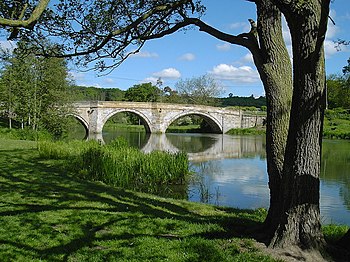
The River Derwent is a river in Yorkshire. A rural river in its upper stretches, if burdened by the needs of extraction and industry its lower reaches, the Derwent is a tributary of the Yorkshire Ouse. The Derwent, curling in an arc from close to the coast inland then south, marks much of the boundary between the East Riding and the North Riding of Yorkshire, assuming that duty from its tributary, the River Hertford.
The Derwent rises on Fylingdales Moor (in the North York Moors National Park) and flows southwards until joined by the River Hertford. From here the river turns westwards, marking the riding boundary through the Vale of Pickering, south through Kirkham Gorge and the Vale of York and joins the River Ouse at Barmby on the Marsh. The confluence is unusual in that the Derwent converges on the Ouse at a shallow angle in an upstream direction.
The River Derwent basin includes such tributaries as the Upper Derwent, River Rye, River Hertford and Bielby Beck, and the waters feeding the Pocklington Canal. It covers an area of 794 square miles and includes the towns of Stamford Bridge, Malton, Pickering, Helmsley, Filey and Scarborough. The area is bounded by the Cleveland Hills, North York Moors and Hambleton Hills to the north, the Yorkshire Wolds and the coast to the east, the Vale of York to the west and the River Ouse and Humber to the south. The area around the river is primarily rural in nature with grazing moorland in the upland areas and a variety of agricultural uses at lower levels. There are large areas of designated conservation sites throughout the area.
Geology
At its source on the North York Moors the River Derwent and its tributaries run over Corallian limestone from the Jurassic geological period. Downstream of Stamford Bridge the catchment area is mainly of Sherwood sandstone from the Triassic period. To the east this sandstone dips under Mercia mudstone, also of the Triassic period.
Some of the underlying rocks are major aquifers and provide a valuable source for water supply in the area. The major aquifers are the Corallian limestone, chalk and Sherwood sandstone. The Corallian limestone outcrops on the hills surrounding the Vale of Pickering and is made up of a series of limestones and sandstones. This aquifer is unconfined in parts and gets water from the River Rye and River Derwent through swallow holes.
Water abstrsction
Water abstracted from the Derwent supplies towns and cities such as Kingston upon Hull, Leeds, York and Scarborough. The river is of generally good quality. It is typical of northerly British rivers in that it exhibits acid flushes at peak times of rainfall, namely during the winter months.
Course
The Derwent rises at Lilla Rig on the North York Moors a few miles from the east coast of Yorkshire.[1] After collecting the waters of the Jugger Howe Beck, Black Beck and Troutdale Beck it flows south through the Forge Valley to West Ayton. From there it continues across lower ground to where it is joined by the River Hertford. The Sea Cut, a man made channel, connects the Derwent to the North Sea near Scarborough to alleviate flooding in the lower reaches of the Derwent, downstream of the Cut. The landscape is upland moors in the upper reaches with lower lying flatter land near Hackness.
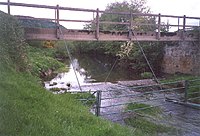
The river flows through the narrow Forge Valley and several designated natural conservation sites. Water is retained behind a weir at West Ayton and there are sink holes in the river bed where river water is lost to underlying aquifers, so that in drought years the river below the weir may run dry.
Having been joined by the River Hertford the Derwent turns sharply west and flows along the Vale of Pickering past Yedingham village and is joined by the River Rye four miles upstream from Malton then flows southwards. The land here is low lying and given over to arable farming. To the south are the Yorkshire Wolds.
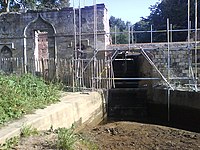
After leaving Malton, the river flows south through the steep sided valley of Kirkham Gorge past Howsham Mill and weir to Buttercrambe.
At Buttercrambe the Derwent continues southwards and through Stamford Bridge, the site of Knig Harold's great, brief victory. The River Derwent Special Area of Conservation is around here.
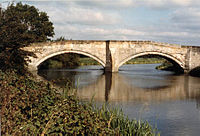
Continuing southwards the Derwent enters the Vale of York and passes Wheldrake, an area of low, undulating, agricultural land. The River Derwent in this area is loaded with many designated riverine conservation sites.
At East Cottingwith the Derwent meanders across its flood plain still going south, and collects the waters of the Bielby Beck and the Pocklington Canal.
At Barmby Barrage the waters of the Derwent are separated from the tidal Ouse to prevent the tides polluting the water extraction plant at Loftsome Bridge. This area consists of the River Derwent from Sutton upon Derwent lock downstream to the confluence with the River Ouse at Barmby Barrage. The land here is largely rural with a few small villages in an agricultural landscape of pastures, meadows and arable fields. The Derwent has been kept non-tidal since the 1970s because water is abstracted at Loftsome Bridge water treatment works to supply the City of Kingston upon Hull.
Natural history
The main river, its tributaries and adjacent wetlands are significant for nature conservation, ecology and landscape. The area contains a wide diversity of habitats and a number of designated sites.
- Special Protection Areas provide protection to birds, their nests, eggs and habitats.(SPA's)
- Special Areas of Conservation contribute to biodiversity by maintaining and restoring habitats and species other than birds.(SAC's)
- Ramsar Sites are wetlands of international importance designated under the Ramsar Convention
- Sites of Special Scientific Interest
Historical interest
Before the last Ice Age the waters of the upper Derwent flowed east and discharged into the sea at Scalby, near Scarborough. The River Hertford, the present middle Derwent and the River Rye flowed east and discharged into the North Sea near Filey Brigg.[2] During the Ice Age these outlets were blocked by a tongue of ice which extended down the North Sea basin carrying with it large amounts of glacial detritus. As the ice melted the detritus was deposited to form the Wykeham morraine and permanently blocked the eastern exits of the watercourse. Water from the melting ice and the North York Moors formed a lake in the Vale of Pickering which expanded and deepened until eventually the water escaped by overflowing at the lowest point at Kirkham. The water cut a gorge through the Howardian Hills as it drained away southwards, breaching the Escrick morraine just east of Wheldrake, and joining the Humber glacial lake.
The unusual upstream facing outfall of the Derwent is man made. It is believed to have been cut during the Roman occupation of Britain to reduce the distance between the Derwent mouth and the Roman legionary headquarters at York by 9 miles. The first navigation weir, also believed to be of Roman origin, was a flash weir built near Wheldrake to raise the level of the river upstream and regulate its flow downstream.[3]
During the reign of King John (1199–1216) a water mill on the Derwent at Wheldrake was given to the monks of Fountains Abbey and later in the thirteenth century a weir is known to have existed at the same place.
By 1462 the Lord Mayor of York was authorised to "correct and amend defects" of the Derwent "from the Ouse as far as the town and bridge of Sutton upon Derwent", so the river must have been navigable at least to Sutton. A corn mill existed at Sutton upon Derwent by 1597. It was rebuilt in 1836 and continued in use until 1960.There are other water mill sites at Stamford Bridge, Buttercrambe, Howsham, Kirkham and Malton.[3]
In 1702, Parliament granted a private Act of Parliament for the improvement of navifgation on the Derwent, with a view in particular to assisting coal barges. The Act authored the proprietors of the scheme to improve the river. Towpaths were laid out and "locks, turnpikes, pens for water, wharfs and warehouses" were constructed. The promoters of these works were allowed to charge tolls on the cargo carried on any part of the river.
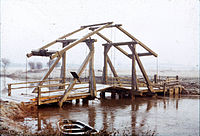
The owners of land near to the river complained in 1722 that the new locks and weirs caused them to lose income because their meadows were more often flooded. In 1793 thirty five vessels were trading from Malton, carrying corn downstream to the West Riding towns and returning upstream with coal. Virtually every village and hamlet near the tidal river had its own landing place.[3]
In 1845 the York and North Midland Railway was built to join the West Riding to Scarborough via Malton. Much of the freight traffic of the Derwent Navigation was transferred to the cheaper railway. In 1855 the railway managers bought the Navigation and to further stifle competition they charged high tolls on barge freight.More cargo was moved to the railway and by the 1890s the only regular trade on the Derwent was on its lower reaches.
By the beginning of the 20th century the river was being used for pleasure craft and by 1920 there were craft based regularly at Stamford Bridge and Kirkham Abbey. After floods in 1930 damaged the lock gates at Kirkham several vessels were stranded upstream.In 1935 statutory Right of Navigation was revoked above Sutton Lock.[3] There followed a long series of fights for public access against riparian interests which continue to the present day.
Towns and villages
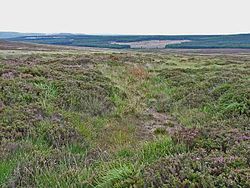
Outside links
| ("Wikimedia Commons" has material about River Derwent, Yorkshire) |
References
- ↑ Danby, Jack (1977). Lilla Cross to Barmby Barrage. Kingston upon Hull: BBC Radio Humberside.
- ↑ Ogden, John (1974). Yorkshire's River Derwent. Lavenham Suffolk England: Terence Dalton Limited. pp. 18–19. ISBN 0900963425.
- ↑ 3.0 3.1 3.2 3.3 Jones, Pat (2000). Navigation on the Yorkshire Derwent. The Oakwood Press. ISBN 0-85361-563-2. OCLC 54319694.
